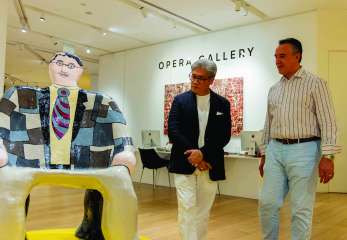A thoroughly enjoyable experience of watching a captivating film or listening to music is highly dependent on the quality of the audio. Arnaud Laborie, CEO of Trinnov Audio, makes the case for their superior products and the technology that goes into it, ensuring a highly immersive and life changing aural experience.
Can you tell us a about your earliest memory of sound and audio that would eventually mark the start of Trinnov Audio?
My earliest memory with sound was when I was about 2 or 3 years old. I remember a photo of me in the living room where my father had a nice hi-fi system. In the photo I was wearing headphones and tweaking the equalizer. My father was also very passionate about sound and I grew up in this environment, which led to a lifelong interested.
When I was a teenager, I was also dabbling in making movies with friends and I liked being in this creative process — to invent things and have all sorts of creative adventures with friends. When I went to university, I joined a hi-fi club and was working with all these loud speakers, amplifiers, and mixing desks. Then I studied signal processing and acoustics, and when I graduated after my master’s degree, I thought about how we could make audio better and would question the next steps in audio technology. At that time, the audio industry was based on audio signals and so the whole industry was trying to make better audio signals.
For those who might not be well versed in the language of audio technology, what is it that Trinnov Audio does? What was the premise for starting the company?
When I started Trinnov with two other university friends, we were trying to think what could be the next big step in audio that would make an instant impact as soon as you hear it. How could we make such a big difference, that even my grandmother could hear and notice it?
To give you an example, talking to someone creates sound. So the sound you produce in the room, which is received from my mouth to a listener’s ears, is also projected in the room and then comes back from the walls in all directions. As a result, it’s very complex, three dimensional, and physical. In order to reproduce all these complexities, we also need to reproduce the sound in all directions. And as early as 2001, we were the first in the world to have an end-to-end, hi-resolution 3-D audio chain. We also came up with a technology called sound optimization, which precisely measures how a room behaves and how sound is produced in a particular room or space.
Fundamentally, this technology is all about how the waves are propagated in the room, how the waves come out of the speakers, acoustic waves coming back to you from another direction, and so on. And all of that, the sound in three dimensions, is in fact the same science. It’s the science of how we can use computers to control sound waves and this is what we’ve been doing at Trinnov.
When you started Trinnov, what was the scene of your industry like and what were the gaps that you hoped to fill?
We established the company in 2003 and at this time, the industry was successful at adapting surround sound for film, commercial cinema, and was later successful when introduced at home, especially with the introduction of the DVD. The DVD was really an accelerator for home theaters and it was the very beginning of surround music, but all of this offered a limited immersive experience. So the gap we tried to fill was improving on how we could make audio 3D, to be how it’s really like in the real world, and to produce a more realistic and even hyper-realistic sound experience.
And what is the end-goal that you hope Trinnov Audio users will achieve?
The ultimate goal is to reproduce a lifelike experience through sound. If I’m talking to you and you close your eyes, you can hear and gauge how for I am from you. And if I stand and walk around, with your eyes still closed, you can tell where I am, what my distance is, and will have a sense of how big the room is.
Your brain will extract all this information because we’ve learned how to analyze the sound field that comes to us. We analyze the fact that it’s not just me talking to you, but it’s reflections coming with a very specific timing that gives you information about how far are the walls and information as to where I am in the room. And if we can reproduce all these information in 3D, it can recreate a lifelike sound experience. So the ultimate goal is that you no longer hear loudspeakers, the walls of the room disappear, and you will hear a completely new soundscape as if you were directly in a real situation and not something that has been recorded and played back. In the end, we hope for users to have a real immersive experience.
For your upcoming product, the Altitude16 Surround Sound Processor, what should we be excited about? How do you think fans of Trinnov Audio will receive it?
With the previous product, the Altitude32, we’ve combined all the knowledge and expertise of Trinnov into a kind of flagship product without any considerations about the cost. And so we’ve created a product that is now perceived as the highest performance product currently available on the market.
With the Altitude16, we tried to preserve the characteristics of the Altitude32 and make it more affordable in order to make immersive sound available to a wider audience. I think we’ve achieved this goal quite well. Now we have a platform that is able to play any format available today. We play them with the maximum performance and Trinnov’s proprietary technology. So we’ve been able to preserve all these characteristics. So now, Trinnov fans will be happy that the company continues its developments and hopefully, we’ll have more and more users in the future.
Speaking of more users, how do you intend to expand your customer base this year?
We are only about to launch the Altitude16 and what I can say is that the market’s response so far is good, so I think it’s going to be a very successful product. So I have no doubts that we will be able to reach more users. At the same time, we identify that some installations will not be enough. So in some particular situations, for example very large rooms with multiple walls, we need more than 32 channels. That said, we will soon introduce a new product with more than 32 channels to make sure that we can offer the absolute best performance.
With such a specialized range of product, how do you intend to win over new customers? Would you say a home theater or specialized set up is essential to enjoy your products?
To have the full immersive sound experience with no compromised qualities, then yes, you need a home theater.
On the other hand, I can see that products like Altitude16 can be used in living rooms because one of the technologies it boasts is called Loudpseaker Remapping Technology. The idea of it is that in a dedicated home theater, you can place the loudspeaker where it should be. But if you want to place many loudspeakers in an existing living room, you really can’t choose where you’re going to put them because of factors like the window, the door, and the furniture around.
So with the Trinnov technology, you can place the speakers where you can and not necessarily where they have to be, and then with the use of the 3D microphone, it will be able to localize where the loudspeakers are, adapting the sound to a specific speaker layout. So with our remapping technology, it always brings the sound back to the where it should be without moving the loudspeaker.
Trinnov Audio is exclusively available at Clarity. For more information, click here






-ADiN.jpg&w=347&h=240&crop-to-fit)
.jpg)
.jpg)




 Back
Back
